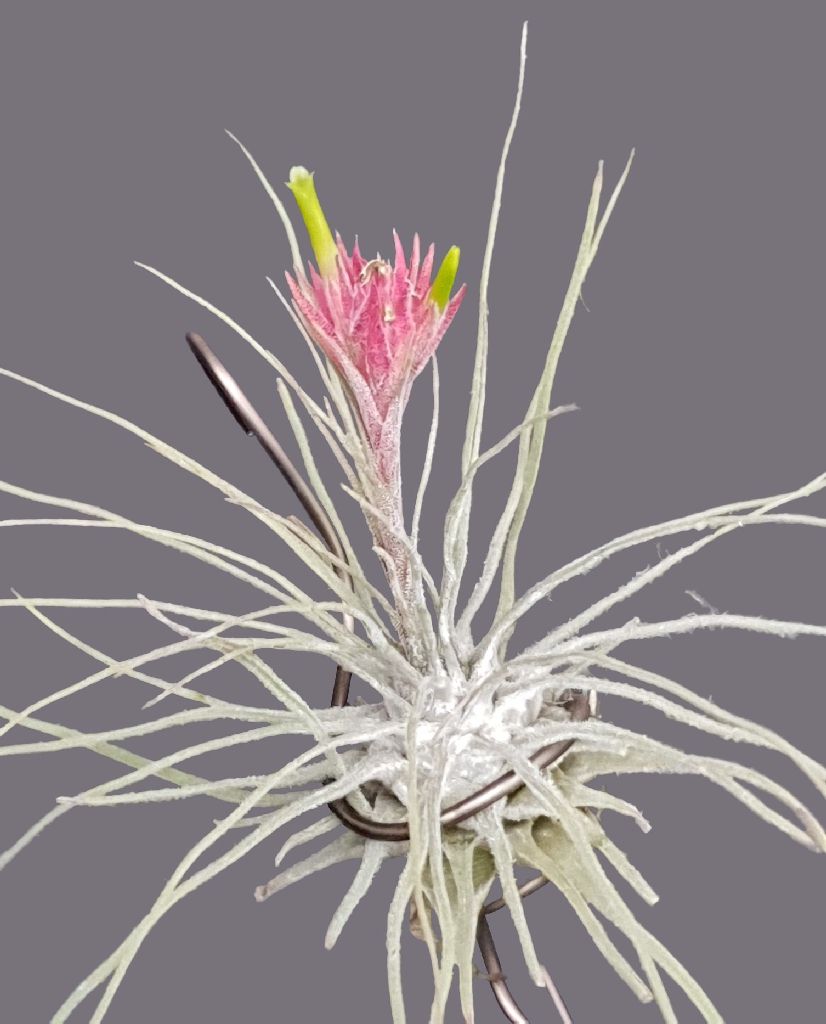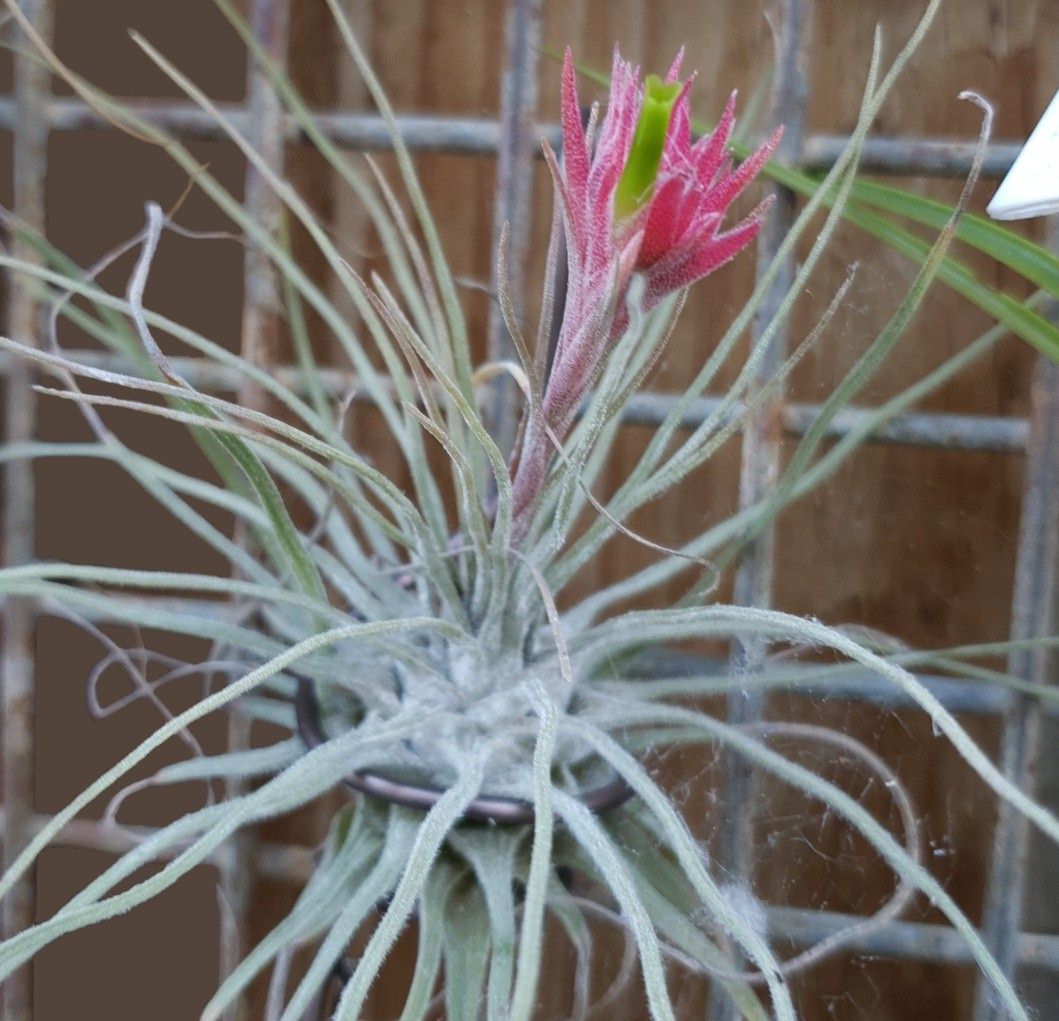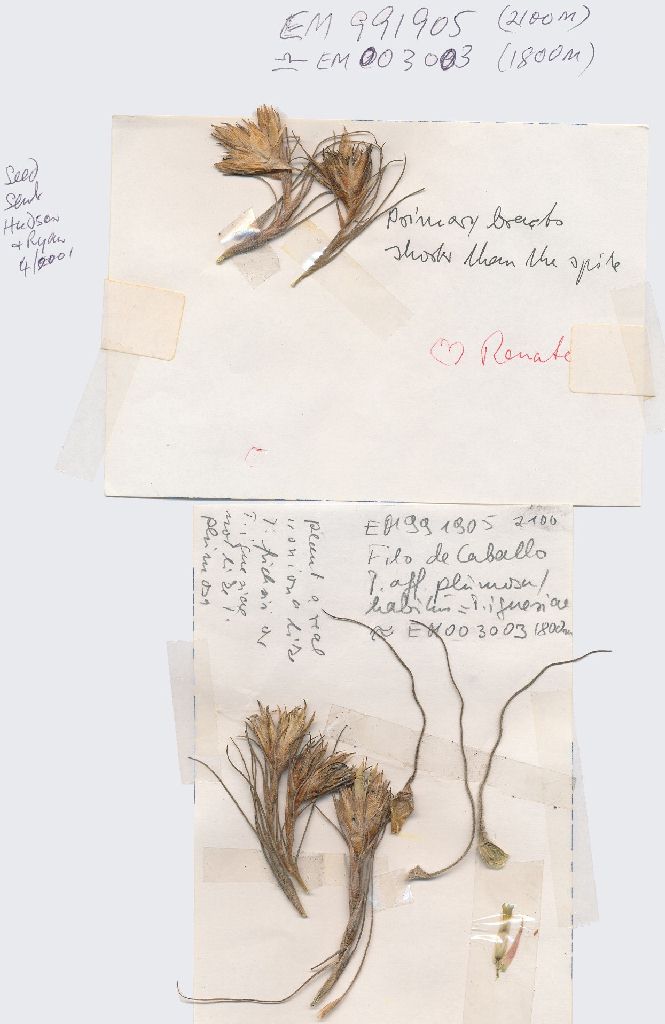


Plant grows individually or in groups with strong branched roots on oak or pine trees, stemless, flowering 7-15 cm high, 7-10 cm diameter.
Leaves forming a spherical rosette, 5-10 cm long, leathery, grey, both sides with dense grey white frosty scales, abaxially dense felt-like.
Sheaths 13-15 mm long, 7-10 mm wide, oval, very distinct from the blades, forming a firm bulb 2-3 cm in diameter, with a 3-4 mm high glabrous base then dense grey scaled.
Blades directly above the sheath only 2 mm wide, 5-8 cm long, bent outwards, the basal ones recurved, undulated after about the first 1 cm, tapering to a long awl-like, filiform tip, dense grey scaled, the edges with large, ciliate, asymmetrical trichomes.
Inflorescence roughly as long as the rosette, almost erect or slightly bent over, its peduncle shorter than the leaf rosette, 5-8 cm long, slender, 2-3 mm in diameter, almost covered by a few scaled, peduncle bracts similar to inner rosette leaves, imbricate (tile-like), sheaths are pink, scaled in the apical half.
The fertile part of the inflorescence with 3-5(-7) dense capitate erect spikes, 2-3 cm long, 1.5-2 cm wide.
Primary bracts similar to the floral bracts, pink, scaled, clearly shorter than the spikes;
spikes are 1-2.5 cm long, 8-10 mm wide, narrow-elliptic acuminate, complanate (compressed), distichous with 2-7 sessile scentless flowers and 1-2 sterile bracts at the base, internodes 3-5 mm,
spike axis thin, almost straight, green, tetragonal, glabrous, not or only a little visible at anthesis.
Floral bracts imbricate, erect, 10-17 mm long, 4-6 mm wide, a little exceeding or as long as the sepals, elliptic pointed or acuminate, thin membranaceous, slightly carinate internally glabrous, somewhat nerved, outside at the base greenish, then intensive pink, dense fine grey scales.
Sepals 10-14 mm long, 3-4 mm wide, narrow-elliptical, acute, thin, dense scales, adaxially carinate and about 1 mm high connate.
Petals 2.2-2.5 cm long, 3 mm wide, green, (#82 moss green from Isley III., P. T 1987, colour chart), base 1.5-2 mm wide and white, almost linear, the obtuse tip erect or just a little bent outwards.
Stamens and pistil enclosed in the flower, filaments 15-17 mm long, all equally long, very thin, flat ribbon-like, white, anthers 1.5-1.7 mm long, 0.5 mm wide, linear, acuminate, fixed at the base, green, pollen lemon-yellow. Pistil shorter than the flower tube, style l0-15 mm long, in the upper part green, then yellowish, stigma tiny, only a little wider than the style, stigma lobes green, erect.
Ovary 2 mm high, 1 mm wide, oval, greenish.
Species name - The name is derived from the type locality Filo de Caballos.
Habitat and Range - In addition to the type locality in Guerrero, where the plant grows near the road to Filo de Caballos at an altitude of 2000-2300 m in large masses, the species was also collected between Altamirano and Ixtapa by the Hromadnik family. Mrs. Lieselotte Hromadnik pointed out that some plants of this collection had white, not green flowers.
Cultivation - In winter Tillandsia caballosensis should be cultivated not too warm and moist, in summer it is recommended to keep the plants outside.
Tillandsia caballosensis belongs to the complex around T. ignesiae Mez and T. plumosa Baker.
It differs from T. ignesiae Mez in the following characteristics: Plant somewhat smaller and leaves more strongly spreading scaled, the edges with large asymmetric trichomes, leaf blades narrow, with filiform tips, after 1 cm clearly undulated. Inflorescence with up to 7 small spikes, which are 1-2,5 cm long, forming a small head, the flowers are more extended, (not a simple, sword-like spike, to 6 cm long and dense imbricate, as with T. ignesiae); floral bracts much narrower, only 4-6 mm instead of 9-10 mm, only very little exceeding the sepals or equally long, very tapered to the tip, usually acuminate, sepals narrow.
It differs from T. plumosa Baker in the following characteristics: Plant somewhat smaller, the sheaths forming a clear bulb shape, the blades thinner, after 1 cm clearly undulated. Peduncle slender, covered by only a few peduncle bracts, not densely enclosing the inflorescence, inflorescence with many larger and up to 7-flowered spikes, the spikes not usually reduced to a single flower. Primary bracts not exceeding the spikes, but clearly shorter.
History - On our trip to Guerrero in December 1999, I first found the plant with Lydia and Gerhard Kohres and Kurt and Helga Bohme on the road to Filo de Caballos for the first time. Because we saw no inflorescences, we thought that it was Tillandsia ignesiae, because the habit was nearly the same. Only the plants were somewhat smaller and the leaves a little more strongly scaled than Tillandsia ignesiae, which we had collected at other locations. Later, when we cleaned the plants in the evening and wanted to pack them, we found some remains of old inflorescences. To our great astonishment, it was not a simple long spike but a small capitulum however, like Tillandsia plumosa. But we were all agreed that it was not Tillandsia plumosa.
At home, the plant flowered after some time, and the inflorescence was composed of several small spikes. However the peduncle was not densely covered with long peduncle bracts but almost bare. Also, the plant has little else in common with Tillandsia plumosa, as it forms a true small solid bulb at the base like T. ignesiae and also has clearly undulated leaf blades.
In December 2000, we drove to the area again where we had found the plants in order to explore it more completely. This time we already found large quantities of the small, star-like, white beauty at a height of 1800 m on oak trees. Here, the plants were somewhat larger and better nurtured than the higher growing forms which we had found on the previous trip.
A few months after our return several plants flowered in my collection from both locations. I was lucky that at the same time Tillandsia plumosa also flowered. To my great joy, Jurgen Lautner told me on the phone that the Tillandsia ignesiae, (which we had found together on 24.03.1998 in Michoacan between Quiroga and Guanajuato), was flowering. He sent me a parcel containing two flowering plants in it. So I now had the whole complex available to compare simultaneously, which really facilitated my work, because now the differences could be determined easily and exactly. It is especially important for me that I always have living and flowering material of new species, and, if possible, also of their close relatives. It would be impossible for me to work solely with herbarium material. Our first assessment, that the plant might be a form of Tillandsia plumosa, not proof true, rather, it belongs to the relationship around T. ignesiae. However differences to the latter were so manifest that the plant should be considered as a separate species.
In February 2004, I was in Guerrero once again with Jurgen and Uli Lautner, Manfred Kretz and Wolfgang Schindhelm. My friends were already very excited because of the plants I had told them about, and we were very eager to know if we would actually be able to find them on the way to Filo de Caballos. On the route from Milpillas we had already seen many interesting tillandsias and photographed them. Particularly at the location where Tillandsia lydiae Ehlers occurs, we remained for a long time exploring and looking for other tillandsias which occur there. Again and again, we had heard from experts the supposition that Tillandsia lydiae is a hybrid. We did not need to search for long in this area at altitude of 800-1000 m to find the plant. But except for Tillandsia lydiae we could only find T. circinnatoides Matuda. After many repeated explorations in different years of the area in which Tillandsia lydiae grows, we can exclude it being a hybrid. Interestingly we discovered some hybrids of T. circinnatoides x T. lydiae.
Tillandsia caput-medusae Morren has its range some hundred metres higher. And here, there were also a lot of hybrids of T. caput-medusae x T. circinnatoides. We found a tree, on which both parents as well as the hybrids grew together. It was photographed diligently, because it was extremely interesting to determine how different the plants were: some resembled more T. circinnatoides, while others more resembled T. caput-medusae.
As we came into higher areas we found Tillandsia caballosensis right and left of the way in several locations, both on light oaks, as well as, somewhat higher, on pine trees. The species is wide-spread in this area.
To our joy, they were in flower and we all took a whole series of photos.